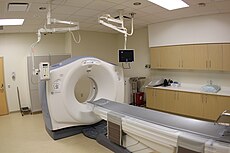


Modern CT scanner
|
You may need a CT scan if you have a problem with a small, bony structure or if you have severe trauma to the brain, spinal cord, chest, abdomen, or pelvis. As with a regular X-ray, sometimes you may be given barium sulfate or a dye to make certain parts of your body show up better.
This simple noninvasive procedure enables medical professionals to quickly and safely obtain sophisticated and accurate diagnostic information on your brain, chest, abdomen, pelvis, spine, and extremities.
Medical imaging is the most common application of X-ray CT. A CT scan can be up to 100 times more sensitive than conventional X-rays, allowing radiologists to distinguish subtle differences in soft tissues that may not be detected with regular X-rays.

CT is often used to image complex fractures, especially ones around joints, because of its ability to reconstruct the area of interest in multiple planes. Fractures, ligamentous injuries and dislocations can easily be recognized with a 0.2 mm resolution.
Tell your doctor if you are pregnant before undergoing a CT scan.